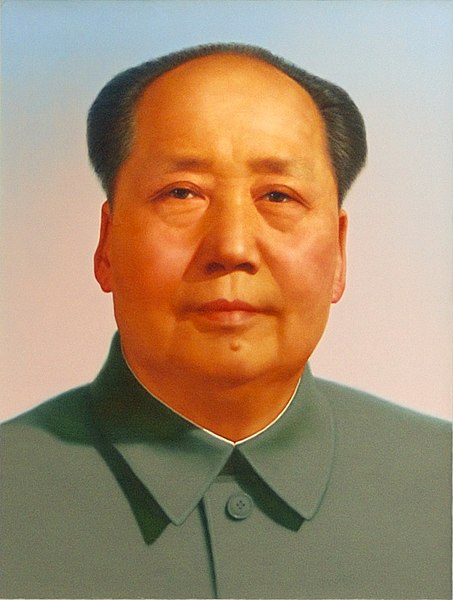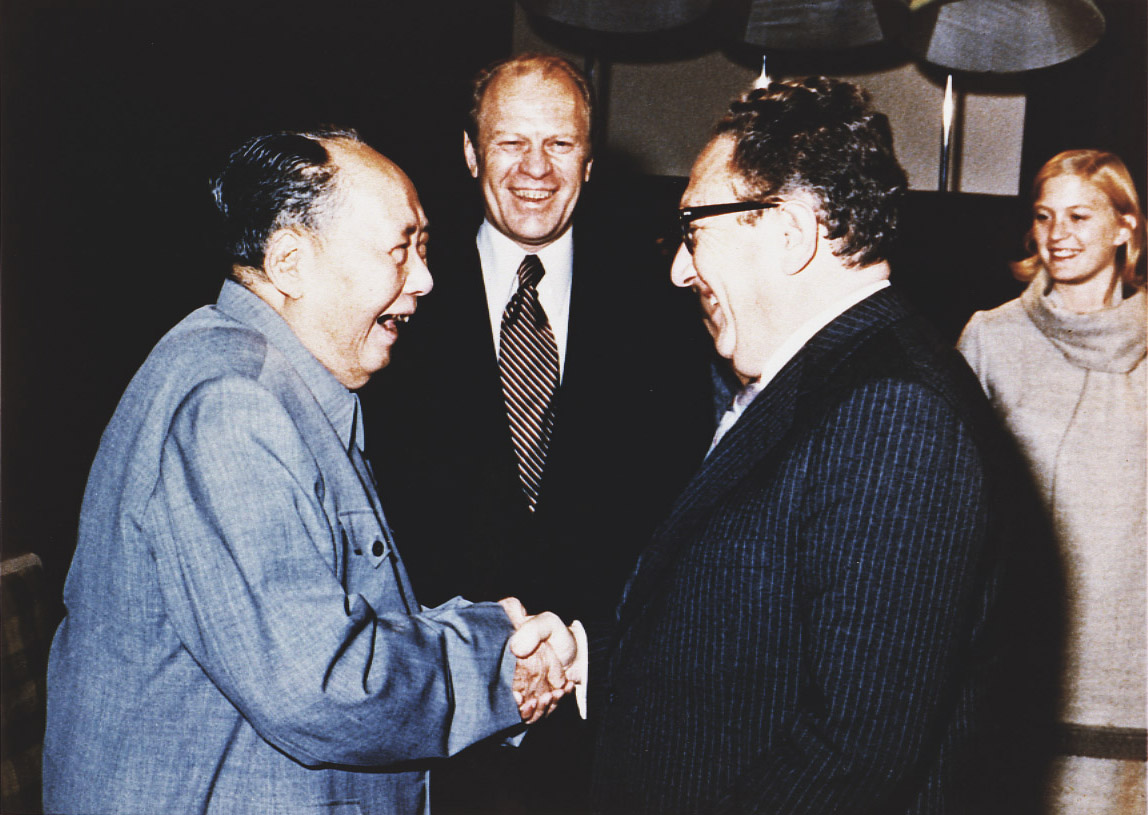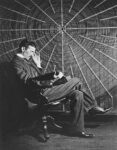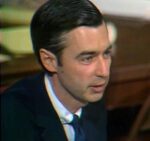To some, Mao Zedong was a much-loved revolutionary hero who saved China from the rule of foreign aggressors. He modernized China by bringing the wonders of western industrialization to their shores. To others, he is remembered for being a sociopathic tyrant who sacrificed the lives of millions of people in order to bring his political experiment to life.
Early Life
By Brücke-Osteuropa – Own work, Public Domain, Link
A farmer and landowner named Mao Yichang was a self-made man. He was born into poverty, but he worked hard, and saved enough to buy two acres of rice paddies. Over the years, he employed workers to tend the land for him, and most of his profits went back into expanding the farm. He built a comfortable life for his wife, Wen Qimei, and their future children. Sadly, Wen Qimei had difficulty getting pregnant, and she lost her first two children during infancy. She gave birth to her one and only child, Mao Zedong, in 1883.
Growing up, Mao Zedong lived a very comfortable life compared to his peers. It was not uncommon for Chinese children to walk around without shoes, and wear clothes that were in tatters. They barely had got enough food to eat, and could not afford proper health care. The fact that Mao Zedong’s parents could afford to provide all of the basic necessities for their child is why some people considered them to be “wealthy”.
The one thing that Mao Zedong had in common with all other children in China was that he was taught the religion and philosophy of Confucianism. One of his most well-known teachings is that everyone should try to go with the flow, and balance the energy of Yin and Yang. When it came to the government, Confucius said that people should try to be satisfied with their lot in life, and they should know their place in order for society to run smoothly. Confucius said, “There is government, when the prince is prince, and the minister is minister; when the father is father, and the son is son.”
However, Mao Zedong did not agree with everything Confucius taught. After all, he knew from first-hand experience that his father was able to work his way out of poverty. He wanted to believe that he could grow up to be more than just a farmer’s son.

In school, Mao Zedong was one of the top students in his class, and he loved reading as many books as he could get his hands on. But at 13 years old, his parents removed him from his elementary school in order to help his father work on the farm. His father tried to arrange a marriage with a young girl named Luo Yigu, who was the daughter of another nearby farmer and landowner. This would have ended his education, and completely sealed his fate. So, he refused to marry her. At 16 years old, he convinced his parents that he wanted to be an intellectual, and his parents agreed to send him to a boarding school in the city of Changsha. Once he was in the city, he met other like-minded people who believed that there needed to be a change in the Chinese way of life.
In the 1800’s, China was seeing more and more trade from western countries. From 1840 to 1842, China and Great Britain had a conflict known as the Opium Wars, and they lost. After signing the Treaty of Nanking, Hong Kong became a British territory, and European traders now had access to Chinese ports.
Even though this was a peace treaty, the Chinese people nicknamed this the “unequal treaties”, because it appeared as though the Qing dynasty was bowing to the demands of Great Britain. China was far from being an industrialized nation. Their technology was so far behind the rest of the world, it was far too easy for western countries to take advantage. In 1895, Japan attempted to overpower China and their influence over Korea, and this was known as the first Sino Japanese War. The cherry on top of an already bad situation came in the year 1908, when the Emperor passed away, and the only male heir to the Qing empire was a 2-year-old named Pu-Yi.
It’s not surprise that people began to lose their faith in the strength Qing dynasty. In 1911, when Mao Zedong was 18 years old, the Xinhai Revolution happened, and The People’s Republic of China brought an end to the Qing dynasty.
The Rise of Communism in China
After switching to The People’s Republic, the overarching government was called The Kuomintang, also known as the Nationalist Party, or the “KMT”. The Kuomintang allowed warlords to rule over their respective territories across China. Each warlord had the power to create their own laws, charge taxes, and raised their own armies.
As a university student, Mao Zedong’s favorite subject was philosophy. He read The Wealth of Nations by Adam Smith, and The Spirit of Laws by Montesquieu. He also read all of the works of the Chinese revolutionaries who were behind the People’s Republic. During this time, he created the Association for Student Self-Government at Hunan First Normal University, so that students could have a voice to protest against the school rules. He also formed a student volunteer army. The group had around 80 members, and they all shared their ideas on government and philosophy.
It was during this time that Mao Zedong was introduced to the work of Karl Marx. Out of all of the political philosophies they studied, he and his friends agreed with the ideas of Communism, because it promised that every person in society would have their basic needs met. Mao Zedong continued to excel in school, and he was number three in his graduating class. He got a job at Beijing University as a librarian, where he was able to read as many books as his heart desired.
The Communist Party of China, or “CCP”, was established in 1921. One of the founders, Li Dazhao, was a librarian at Peking University. The other was Chen Duxiu, who was an intellectual who had been apart of establishing the People’s Republic of China. After seeing how China adjusted to the new republic, Duxiu believed that the warlords were taking advantage of the peasant class, and that the political system needed adjusting. He thought Communism would actually be a better for their society. Mao Zedong was just 28 years old at the time, and he was one of many young people who began attending Communist meetings after work.
Once people began to learn about the teachings of Karl Marx, The Communist Party of China was gaining a huge following. Many peasant people were unhappy with their respective warlords, and they wanted a new system of government. Of course, Communism was posing a huge threat to the Nationalist Party. Unlike the rest of the parties in the republic, Communism actually had the potential to spread across the entire country and replace them as the leading party. They believed it was time to get rid of the Communists in China before they gained too much power.
In 1927, a gang working for the KMT attacked and killed members of the Communist Party. They announced the plan to eradicate every single member of the CCP. This event is remembered as The Shanghai Massacre, or the “April 12th Purge”. Over 300,000 Communists were killed, and 50,000 people denounced their party affiliation out of fear.
The Shanghai Massacre is credited for starting the Chinese Civil War. Since the KMT was the original party of the Republic of China, they felt that it was time for them to eliminate the feudal system of warlords and the Communists in order to unite all of China under one government.
The Long March, and the Second Sino-Japanese War
In 1931, when Mao Zedong was 48 years old, he was elected as the Chairman of the Communist party. In 1934, the Chinese Civil War was still raging on. Mao Zedong lead the members of the Communist Party in what is remembered as The Long March. They trekked over 4,000 miles through mainland China in their attempt to fend off KMT forces. The leader of the Nationalist Party, Chiang Kai-Shek, was sending troops after the Communists, and he ran several campaigns in his attempt to defeat them. Mao Zedong did not have an army as large as the KMT, but he had his charisma. Wherever they went, he used his power of persuasion to tell the villagers that Communism would improve their lives. He promised them that they would never go hungry again. People were so unhappy living under the rule of their warlords, that it wasn’t very hard to convince people to fight for the cause. After losing thousands of men in battle, Zedong would just restock his army with new peasants in the next village, and keep moving forward.
In 1937, all of China would have to hit “pause” on their Civil War, because Japan was taking advantage of the chaos by invading Manchuria. This was known as the Second Sino-Japanese War. For years, Japan attempted to take over Chinese territories. The Japanese tortured, killed, and raped Chinese civilians everywhere they went, and decimated major cities. The armies of the warlords and KMT were already weakened from their losses sustained while fighting each other. There was no way they could fend off the Japanese Empire on their own.
The leader of the KMT, Chiang Kai-shek, had to swallow his pride and ask the Communist party for help. Their Red Army was growing in numbers. They defended China against the Japanese in what is known as The Hundred Regiments Offensive. The Red Army was largely made up of peasants who didn’t have time for proper military training, so Mao Zedong used guerrilla warfare tactics. They also called in some help of the USSR, who closed in on Japanese-occupied Manchuria from one side, while China was on the other. They succeeded in saving the country.
However, once the Japanese were gone, the Civil War was back on. In 1946, Mao Zedong and his Red Army defeated the KMT, and became the new rulers of China.
At this point, people thought Mao Zedong was a national hero, and the rightful leader of their country. Not only did he save them from the Japanese, but he also unified the country under one rule for the first time since the Qing dynasty. People were hopeful that things would finally start to change for the better, but actually, they were about to get a whole lot worse.

By неизвестный (unknown) – http://sarbaharapath.com/wp-content/uploads/2015/11/Mao2.jpg, Public Domain, Link
The Great Leap Forward
In 1958, Mao Zedong officially began his plan, which was called “The Great Leap Forward”. This was his attempt to use Communist ideals to bring modern industrialization to China. He may have had the best intentions at heart, but no matter how many books one may read about creating a new society, there is a huge difference between theory, and actually doing something in real life.
The Great Leap Forward created a major land reform where citizens were no longer allowed to own private property. Farmers had to give up their land to the “greater good” of the public. They still had to work, but they were not allowed to keep the food they were growing, because the rules dictated that people who were far more important to society deserved nourishment, first, and then peasants could be fed with whatever was left.

By Unknown – http://news.xinhuanet.com/politics/2013-12/14/c_125858487_11.htm, Public Domain, Link
He sent medical services to all Chinese villages, ensuring that all of its citizens had health care, and were fit enough to do manual labor. He commanded many of the people of China to start constructing factories and new government buildings. Most peasants were farmers their entire lives, and they had absolutely no experience working in factories. They were still expected to produce steel and other industrialized materials. There were so many people now working in factories, it was impossible to properly train or manage everyone. Despite having a lot of issues getting adjusted to the new policy, the plan actually worked for a very short window of time. Crop production went up, and people were healthier, and had more food to eat than ever before. Despite their setbacks, the Chinese people were able to erect a few modern buildings, as well.
This progress all came crashing down less than a year into the plan, in the winter of 1959. Mao Zedong had suggested that farmers grow more grain, and it was stored in silos. However, without growing other types of food to store for the winter months, it meant that people were expected to only survive on bread alone. The weather that year was awful, as well. They experienced widespread droughts, followed by massive typhoons that caused flooding that destroyed crops. Tigers, leopards, and wolves were attacking farmers as they tried to cultivate more land. So he created an “anti-pest campaign” where he encouraged people to shoot these animals on sight, and eat their meat. This pushed tigers and leopards near extinction, and people killed 75% of the population.
This Great Leap Forward was actually a huge step backwards for China, and it caused a widespread famine that killed millions of people. People resorted to eating household pets like dogs and cats in order to survive. Some even resorted to cannibalism. In 1959, he was so unpopular, he had to actually step down as Chairman of the Communist party, and handed his position as State Chairman over to a more moderate party representative, Li Shaoqi. However, Mao Zedong continued to work in a leading position in the government, and tried to run his Great Leap Forward behind the scenes.
Instead of recognizing that his policy was doomed to fail, Mao Zedong was convinced that this was just bad luck, and pressed the people to keep going. However, people just continued to die year after year. Finally, in 1961, the “The Great Leap Forward” was canceled. By the time he finally ended the policy, 36 million people had died.

By Unknown – http://www.ibiblio.org/chineseart/contents/peop/c04.html http://www.chinanews.com/mil/2015/05-18/7283505.shtml, Public Domain, Link
The Cultural Revolution
You would think that after being responsible for the deaths of tens of millions of people without somehow being lynched by an angry mob, you would know when to quit. But in 1966, Mao Zedong tried to regain the trust of the people, and become State Chairman once again. He had to place the blame for his mistakes elsewhere. He claimed that the “bourgeoisie”- or the top 1% were ruining everything, and that he was truly on the side of the peasant people.
He built up a cult of personality, and people strongly supported him, because they remembered him as the revolutionary hero who saved their country from the Japanese, and provided them with food rations and free healthcare. His followers were willing to do anything he asked.
He knew from his days of leading college students in rallies that young people are the perfect for molding into revolutionaries. He convinced a group of students called “The Red Guard” to seek out anyone who was speaking out against the Communist party. He encouraged them to even murder their professors who spoke against Mao Zedong’s policies in order to make an example of them. According to some accounts, Mao’s Red Guards were so savage, they partook in “flesh banquets”, or ritualist cannibalism of their enemies.
Mao Zedong called the USSR and North Korea “traitor revisionists” who were bastardizing the original work of Karl Marx. His interpretation of Communism was so different from the rest of the world, many called his philosophy “Maoism”. Instead of isolating his people from the outside world like other Communist nations, he encouraged globalization and open trade, which is why China’s economy eventually rebounded, and it set the stage for the economic strength that it has today.

By Unknown – Helsingin Sanomat, Public Domain, Link
In 1968, the minister of Pakistan brought a gift of 40 mangoes to Chairman Mao. People in China had never eaten tropical fruit before, so this was a delicacy to them. Mao couldn’t possibly eat 40 mangoes on his own, so he handed out the fruit to his political team, and a couple got into the hands of a group of factory workers. They were so mesmerized by this magical, sweet fruit, that they literally started to worship it, saying that it was a symbol of the wonderful new things Chairman Mao would bring to their land. They placed it in a glass case, and when the fruit went bad, the replaced it with a wax replica. One man, who had never tried a mango before, questioned why everyone was worshiping this piece of fruit. He tried to compare it to a sweet potato…Mangoes couldn’t possibly be that great, right? Well, even the mere suggestion that a mango wasn’t a magical fruit was enough to kill the man for treason. This is just one of many examples of how irrationally devoted people were to Mao Zedong.
In the year 1970, when the country was running low on building supplies, Mao Zedong ordered his workers to tear down The Great Wall of China in order to use the bricks to build new houses and a dam. He also destroyed ancient artwork or anything that was considered to be a symbol of the bourgeoisie. He was willing to dismantle thousands of years of Chinese history and culture in order to execute his Communist vision.
Later Life, and Death
When he was getting older, Mao Zedong was shameless when it came to reaping the benefits of being a Communist dictator. He almost never bathed or brushed his teeth, and claimed that he cleaned himself inside the bodies of his mistresses. Not surprisingly, he contracted sexually transmitted infections, and spread them to several women, who actually wore their illness as a badge of honor, since it was given to them by the Chairman Mao. When he was in his 60’s, he appointed a 16-year old girl named Zhang Yufeng to be his personal secretary. She spent so much time with him, that even Mao Zedong’s wife had to go through Zhang Yufeng first before she could make an appointment to speak with her husband.

By Unknown / Courtesy Gerald R. Ford Library – http://www.fordlibrarymuseum.gov/avproj/State_Trips_PRC.asp, specifically http://www.fordlibrarymuseum.gov/images/avproj/pop-ups/A7912.html, Public Domain, Link
In 1973, he was sitting in a trade meeting with Henry Kissinger, and he reportedly offered to trade 10 million Chinese women to the United States. He said that women caused too many problems, and that it would be better to just get rid of them. In 1974, his third wife, the beautiful actress Jiang Qing, decided she would not sit around waiting for her husband’s respect and affection. She began gathering her own collection of young male lovers. She got so bold, she would even allow her boyfriends to show up at their house, and Mao never protested her affairs.
When he died in 1976, his people were devastated. He was buried in a crystal casket so that people could see his body when they came to visit. Lines of people queued up to pay their respects, and many of them openly cried when they saw the body of their dead leader. Even to this day, the memory of Mao Zedong is revered by many, as they remember him as one of the great heroes of the nation.
Love him or hate him, China would be a very different place today if it were not for Mao Zedong. Without him, China may never be the leading economic powerhouse that it is today…It only took sacrificing millions of lives to get there.
Sources:
https://www.history.com/topics/qing-dynasty
http://afe.easia.columbia.edu/special/china_1900_mao_early.htm
https://www.history.com/topics/long-march
http://www.bbc.co.uk/history/historic_figures/mao_zedong.shtml
https://www.youtube.com/results?search_query=mao+zedong+documentary
https://www.nytimes.com/1993/01/06/world/a-tale-of-red-guards-and-cannibals.html
https://www.telegraph.co.uk/news/worldnews/asia/china/9914895/How-China-came-to-worship-the-mango-during-the-Cultural-Revolution.html
https://en.wikipedia.org/wiki/Red_Guards
https://www.history.com/topics/cultural-revolution



